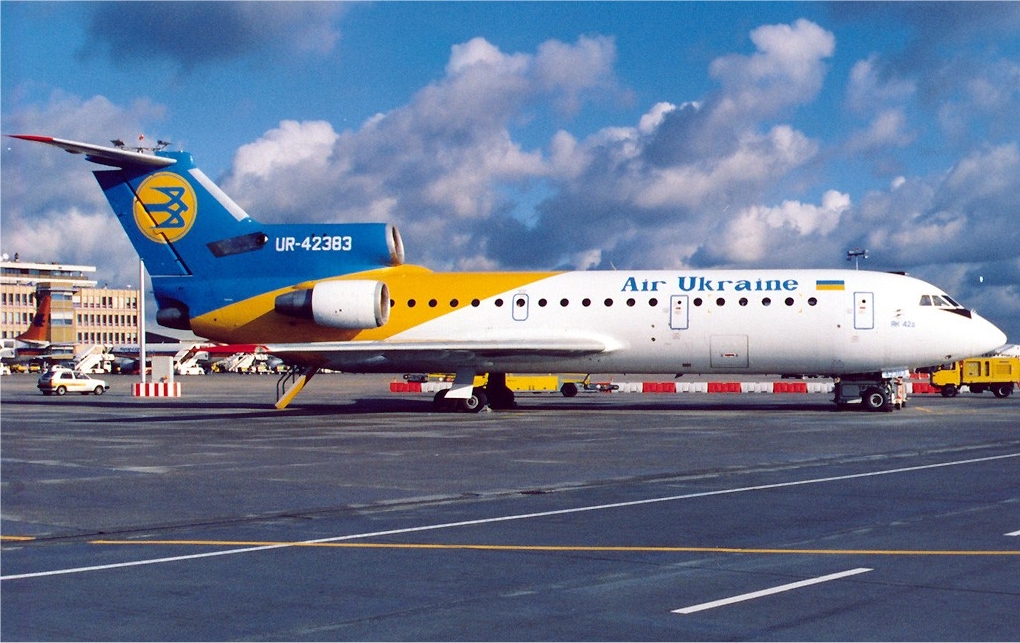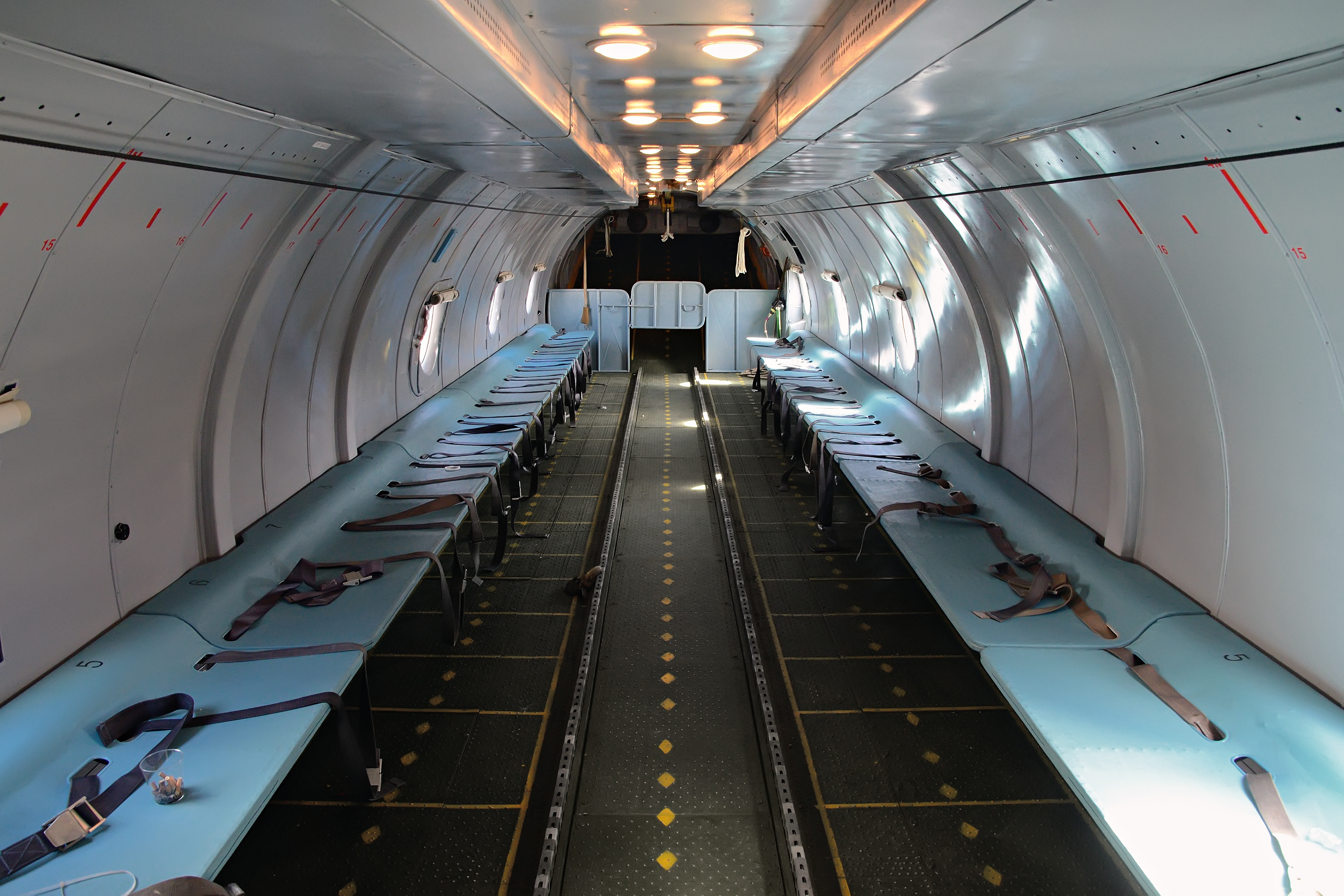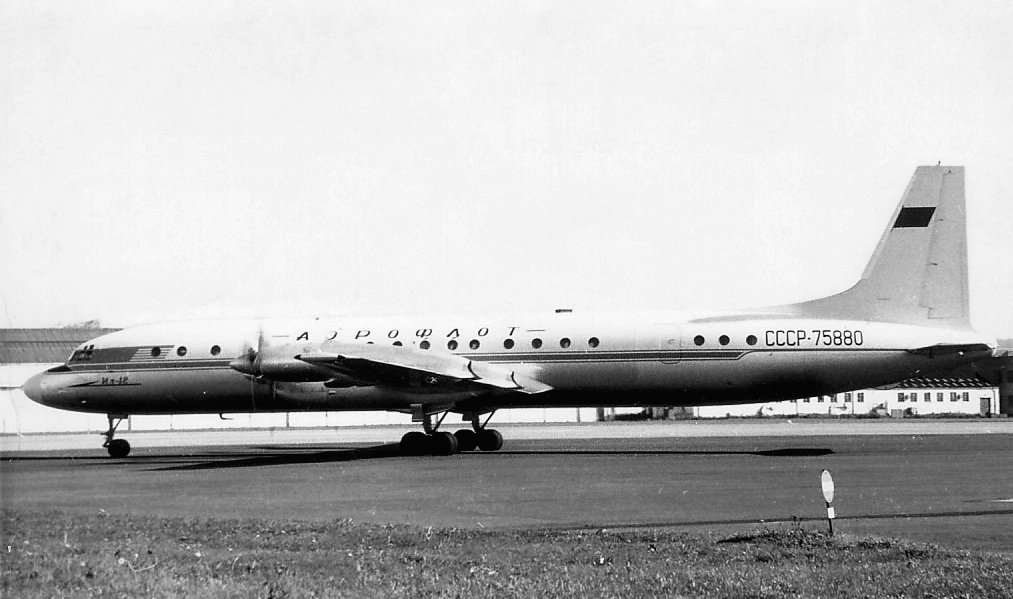|
Air Ukraine
Air Ukraine ( uk, Авіалінії України ''Avialiniyi Ukrayiny'') was a state-owned airline from Ukraine, serving as flag carrier of the country from 1992 to 2002. Headquartered in Kyiv, Air Ukraine operated scheduled passenger and cargo flights mostly on domestic routes or within the Commonwealth of Independent States, but also to global destinations. History The Dissolution of the Soviet Union during 1990 and 1991 lead to the split-up of former Soviet carrier Aeroflot in 1992, with Air Ukraine being founded out of the Aeroflot's Kyiv directorate. Soon, other Ukrainian divisions were merged into it to create a national airline. In December 2002, Air Ukraine was declared to be bankrupt. Attempts to relaunch the company by merging it with Aerosvit Airlines or Ukraine International Airlines failed, and the airline license was finally withdrawn on 23 July 2004. Fleet Over the years, Air Ukraine operated the following aircraft types: Incidents *On 5 September 1 ... [...More Info...] [...Related Items...] OR: [Wikipedia] [Google] [Baidu] |
Air Operator's Certificate
An air operator's certificate (AOC) is the approval granted by a civil aviation authority (CAA) to an aircraft operator to allow it to use aircraft for commercial purposes. This requires the operator to have personnel, assets, and system in place to ensure the safety of its employees, and the general public. The certificate will list the aircraft types, and registrations to be used, for what purpose and in what area – specific airports or geographic region. Categories AOCs can be granted for one or more of the following activities: *Aerial advertising *Aerial photography * Aerial spotting *Aerial surveying *Air ambulance or aeromedical * Charter (low capacity and high capacity) * Firefighting *Flight training *Regular public transport (RPT) (low capacity and high capacity) Low capacity operations is when operating aircraft with under 38 passenger seats, high capacity is above that. Requirements The requirements for obtaining an AOC vary from country to country, but are gene ... [...More Info...] [...Related Items...] OR: [Wikipedia] [Google] [Baidu] |
Antonov An-26
The Antonov An-26 ( NATO reporting name: Curl) is a twin-engined turboprop civilian and military transport aircraft, designed and produced in the Soviet Union from 1969 to 1986.Gordon, Yefim. Komissarov, Dmitry & Sergey. "Antonov's Turboprop Twins". Hinkley. Midland. 2003. Development While the An-24T tactical transport had proved successful in supporting Soviet troops in austere locations, its ventral loading hatch restricted the handling of cargo, and in particular vehicles, and made it less effective than hoped in parachuting men and supplies. As a result, interest in a version with a retractable cargo ramp increased, and the Antonov design bureau decided in 1966 to begin development on the new An-26 derivative, in advance of an official order. The cargo ramp was based on that design and allowed the cargo deck to be sealed and pressurised in flight. When loading cargo, it could either be lowered to allow vehicles to be driven in, or slid beneath the aircraft's fuselage, so th ... [...More Info...] [...Related Items...] OR: [Wikipedia] [Google] [Baidu] |
Yakovlev Yak-40
The Yakovlev Yak-40 (russian: Яковлев Як-40; NATO reporting name: Codling) is a regional jet designed by Yakovlev. The trijet's maiden flight was in 1966, and it was in production from 1967 to 1981. Introduced in September 1968, the Yak-40 has been exported since 1970. Development By the early 1960s, Soviet international and internal trunk routes were served by Aeroflot, the state airline, using jet or turboprop powered airliners, but their local services, many of which operated from grass airfields, were served by obsolete piston-engine aircraft such as the Ilyushin Il-12, Il-14 and Lisunov Li-2.Stroud 1968, p. 269–270. Aeroflot wanted to replace these elderly airliners with a turbine-powered aircraft, with the Yakovlev design bureau being assigned to design it. High speed was not required, but it would have to be able to operate safely and reliably out of poorly equipped airports with short (less than 700 m or 2,300 ft) unpaved runways in poor weather.Gunsto ... [...More Info...] [...Related Items...] OR: [Wikipedia] [Google] [Baidu] |
Tupolev Tu-154
The Tupolev Tu-154 (russian: Tyполев Ту-154; NATO reporting name: "Careless") is a three-engined, medium-range, narrow-body airliner designed in the mid-1960s and manufactured by Tupolev. A workhorse of Soviet and (subsequently) Russian airlines for several decades, it carried half of all passengers flown by Aeroflot and its subsidiaries (137.5 million/year or 243.8 billion passenger-km in 1990), remaining the standard domestic-route airliner of Russia and former Soviet states until the mid-2000s. It was exported to 17 non-Russian airlines and used as a head-of-state transport by the air forces of several countries. The aircraft has a cruising speed of and a range of . Capable of operating from unpaved and gravel airfields with only basic facilities, it was widely used in the extreme Arctic conditions of Russia's northern/eastern regions, where other airliners were unable to operate. Originally designed for a 45,000-hour service life (18,000 cycles), but capable of 80, ... [...More Info...] [...Related Items...] OR: [Wikipedia] [Google] [Baidu] |
Tupolev Tu-134
The Tupolev Tu-134 (NATO reporting name: Crusty) is a twin-engined, narrow-body jet airliner built in the Soviet Union for short and medium-haul routes from 1966 to 1989. The original version featured a glazed-nose design and, like certain other Russian airliners (including its sister model the Tu-154), it can operate from unpaved airfields. One of the most widely used aircraft in former Comecon countries, the number in active service is decreasing because of operational safety concerns and noise restrictions. The model has seen long-term service with some 42 countries, with some European airlines having scheduled as many as 12 daily takeoffs and landings per plane. In addition to regular passenger service, it has also been used in various air force, army and navy support roles; for pilot and navigator training; and for aviation research and test projects. In recent years, a number of Tu-134s have been converted for use as VIP transports and business jets. A total of 854 Tu-1 ... [...More Info...] [...Related Items...] OR: [Wikipedia] [Google] [Baidu] |
Let L-410 Turbolet
The Let L-410 Turbolet is a twin-engine short-range transport aircraft, manufactured by the Czech aircraft manufacturer Let Kunovice (named Aircraft Industries since 2005), often used as an airliner. The aircraft is capable of landing on short and unpaved runways and operating under extreme conditions from . By 2016, 1,200 L-410s had been built, and over 350 are in service in more than 50 countries. Development Development of the L-410 was started in the 1960s by the Czechoslovak aircraft manufacturer Let Kunovice. The Soviet airline Aeroflot was looking for a turboprop-powered replacement for the Antonov An-2 aircraft, initiating the design development by Let. After preliminary studies of an aircraft called the L-400, a new version was introduced called the L-410 Turbolet. The first prototype, designated XL-410, flew on April 16, 1969. Because of delays in the development of a suitable Czech engine (Walter M601), the prototype and first production version were powered by Pra ... [...More Info...] [...Related Items...] OR: [Wikipedia] [Google] [Baidu] |
Ilyushin Il-76
The Ilyushin Il-76 (russian: Илью́шин Ил-76; NATO reporting name: Candid) is a multi-purpose, fixed-wing, four-engine turbofan strategic airlifter designed by the Soviet Union's Ilyushin design bureau. It was first planned as a commercial freighter in 1967, as a replacement for the Antonov An-12. It was designed to deliver heavy machinery to remote, poorly served areas. Military versions of the Il-76 have been widely used in Europe, Asia and Africa, including use as an aerial refueling tanker or command center. The Il-76 has seen extensive service as a commercial freighter for ramp-delivered cargo, especially for outsized or heavy items unable to be otherwise carried. It has also been used as an emergency response transport for civilian evacuations as well as for humanitarian aid and disaster relief around the world. Due to its ability to operate from unpaved runways, it has been useful in undeveloped areas. Specialized models have also been produced for aerial fir ... [...More Info...] [...Related Items...] OR: [Wikipedia] [Google] [Baidu] |
Ilyushin Il-62
The Ilyushin Il-62 (russian: Илью́шин Ил-62; NATO reporting name: Classic) is a Soviet long-range narrow-body jetliner conceived in 1960 by Ilyushin. As successor to the popular turboprop Il-18 and with capacity for almost 200 passengers and crew, the Il-62 was the world's largest jet airliner when first flown in 1963. One of four pioneering long-range designs (the others being Boeing 707, Douglas DC-8, and Vickers VC10), it was the first such type to be operated by the Soviet Union and a number of allied nations. The Il-62 entered Aeroflot civilian service on 15 September 1967 with an inaugural passenger flight from Moscow to Montreal, and remained the standard long-range airliner for the Soviet Union (and later, Russia) for several decades. It was the first Soviet pressurised aircraft with non-circular cross-section fuselage and ergonomic passenger doors, and the first Soviet jet with six-abreast seating (the turboprop Tu-114 shared this arrangement) and intern ... [...More Info...] [...Related Items...] OR: [Wikipedia] [Google] [Baidu] |
Ilyushin Il-18
The Ilyushin Il-18 (russian: Илью́шин Ил-18; NATO reporting name: Coot) is a large turboprop airliner that first flew in 1957 and became one of the best known and most durable Soviet aircraft of its era. The Il-18 was one of the world's principal airliners for several decades and was widely exported. Due to the aircraft's airframe durability, many examples achieved over 45,000 flight hours and the type remains operational in both military and (to a lesser extent) civilian capacities. The Il-18's successor was the long range Il-62 jet airliner. Design and development Two Soviet aircraft shared the designation Ilyushin Il-18. The first Il-18 was a propeller-driven airliner of 1946 but after a year of test flights that programme was abandoned. In the early 1950s with a need to replace older designs and increase the size of the Soviet civil transport fleet, a Soviet Council of Ministers directive was issued on 30 December 1955 to the chief designers Kuznetsov and Ivchenko ... [...More Info...] [...Related Items...] OR: [Wikipedia] [Google] [Baidu] |
Boeing 737-400
The Boeing 737 Classic is a series of narrow-body airliners produced by Boeing Commercial Airplanes, the second generation of the Boeing 737 series of aircraft. Development began in 1979 and the first variant, the 737-300, first flew in February 1984 and entered service that December. The stretched 737-400 first flew in February 1988 and entered service later that year. The shortest variant, the 737-500, first flew in June 1989 and entered service in 1990. Compared to the original series, the classic series was re-engined with the CFM56, a high-bypass turbofan, for better fuel economy and had upgraded avionics. With a MTOW, it has a range of . At the -500 is similar in length to the original 737-200 and can fly 110 to 132 passengers. The -300 can seat 126 to 149 passengers while the -400 accommodates 147 to 168 seats. It competed with the McDonnell Douglas MD-80 series, then with the Airbus A320 family which prompted Boeing to update its offer with the 737 Next Gener ... [...More Info...] [...Related Items...] OR: [Wikipedia] [Google] [Baidu] |
Boeing 737-300
The Boeing 737 Classic is a series of narrow-body airliners produced by Boeing Commercial Airplanes, the second generation of the Boeing 737 series of aircraft. Development began in 1979 and the first variant, the 737-300, first flew in February 1984 and entered service that December. The stretched 737-400 first flew in February 1988 and entered service later that year. The shortest variant, the 737-500, first flew in June 1989 and entered service in 1990. Compared to the original series, the classic series was re-engined with the CFM56, a high-bypass turbofan, for better fuel economy and had upgraded avionics. With a MTOW, it has a range of . At the -500 is similar in length to the original 737-200 and can fly 110 to 132 passengers. The -300 can seat 126 to 149 passengers while the -400 accommodates 147 to 168 seats. It competed with the McDonnell Douglas MD-80 series, then with the Airbus A320 family which prompted Boeing to update its offer with the 737 Next Gene ... [...More Info...] [...Related Items...] OR: [Wikipedia] [Google] [Baidu] |
Boeing 737-200
The Boeing 737 is a narrow-body aircraft produced by Boeing at its Boeing Renton Factory, Renton Factory in Washington (state), Washington. Developed to supplement the Boeing 727 on short and thin routes, the twinjet retains the Boeing 707, 707 fuselage width and six abreast seating with two underwing turbofans. Envisioned in 1964, the initial 737-100 made its first flight in April 1967 and entered service in February 1968 with Lufthansa. The lengthened 737-200 entered service in April 1968, and evolved through four generations, offering several variants for 85 to 215 passengers. The 737-100/200 original variants were powered by Pratt & Whitney JT8D low-bypass engines and offered seating for 85 to 130 passengers. Launched in 1980 and introduced in 1984, the Boeing 737 Classic, 737 Classic -300/400/500 variants were re-engine, upgraded with CFM International CFM56#CFM56-3B-1, CFM56-3 turbofans and offered 110 to 168 seats. Introduced in 1997, the Boeing 737 Next Generation, 7 ... [...More Info...] [...Related Items...] OR: [Wikipedia] [Google] [Baidu] |


_Tulpar_Air).jpg)


.jpg)
_(2).jpg)



